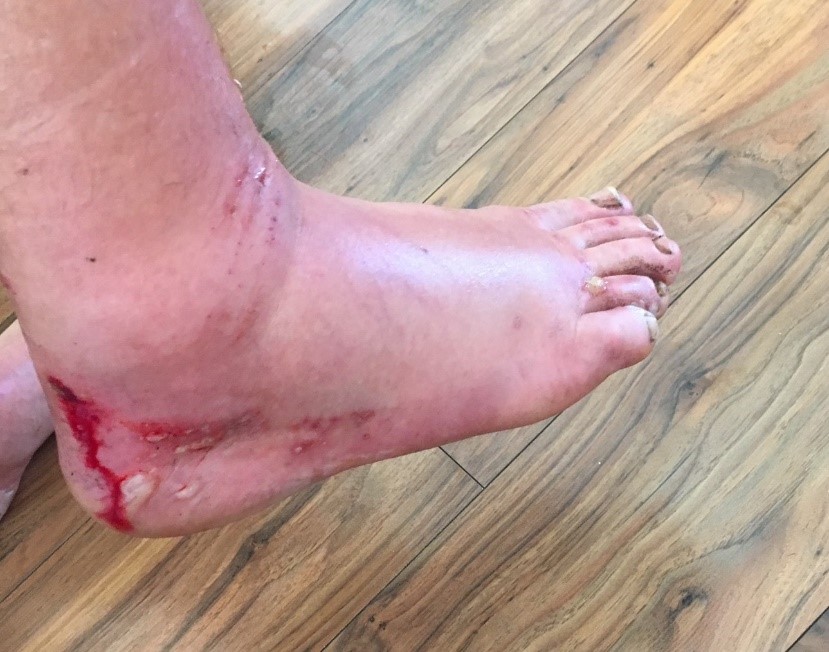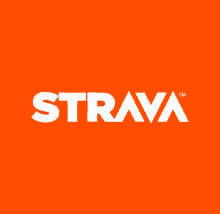Lakeland 100 Report, by Nick Sheard
Lakeland 100
2019 race report by Nick Sheard
Lakeland 100 is a continuous 105 mile clockwise circular loop of the Lake District starting and finishing in Coniston. The route is unmarked and competitors have to navigate using a route description, map and compass and ‘register’ at checkpoints along the route. There is a 40-hour cut-off time for completion.
- 2019 winning times = 21 hours 27 minutes 05 seconds (M) & 26 hours 19 minutes 27 seconds (F)
- My time = 38 hours 23 minutes 01 second
- Finished 205/ 265 finishers; 500 starters
- Started 6pm Friday 26 July, finished 08:23am Sunday 28 July
- Total time awake without sleep = 51 hours
- Youngest finisher = 18 years old; oldest finisher = 70 years old
Playlist:
Enlightenment (Van Morrison), Not Dark Yet (Bob Dylan), When the Night Comes (The Boomtown Rats), One Way (The Levellers), And Dream of Sheep (Kate Bush), Night Running (Cage the Elephant), Morning (Beck), Let the Day Begin (The Call), Heaven is a Place on Earth (Belinda Carlisle), Fall On Me (R.E.M.), The Mountain (Maddison’s Thread), Keep Moving (Madness), Clocks (Coldplay), Comfortably Numb (Pink Floyd), In The Still of the Night (The Five Satins) Golden Slumbers/Carry That Weight/The End (The Beatles)
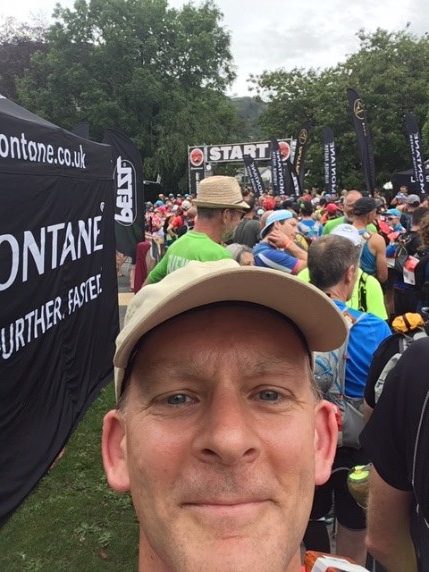
“We are judged not by what we start, but by what we finish.”
Leg 1 Coniston to Seathwaite, 7 miles
Highlights = fresh legs and no blisters; the imposing eastern precipice of Dow Crag viewed from the Walnar Scar Road; sun starting to set over the west Cumbrian coast; the views of the Scafell Range and Harter Fell before the descent to Seathwaite; the company of fellow runners and the support of spectators.
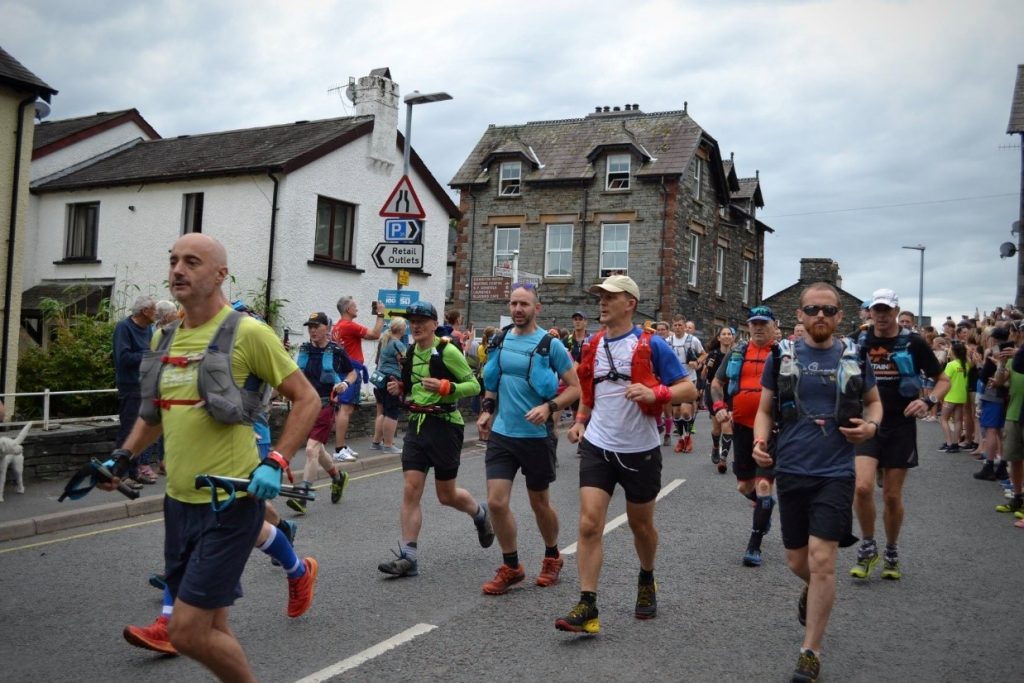
Coniston village, 6.04pm Friday 27 July. 0.2 miles covered.
Mandatory kit includes hat, gloves, headtorch, survival bivi bag, first aid kit, waterproof jacket and trousers, emergency food, whistle, compass, map of the route, spare batteries, spare base layers, fully charged mobile phone.
500 competitors started the Lakeland 100 in 2019. The ‘race’ starts at 6pm on the Friday evening with a 40-hour time limit for completion. There are 15 checkpoints along the route, each one with a race elimination cut off time. Any competitors not leaving the checkpoint by that time are eliminated from the race and driven back to the start in a ‘broom wagon’. The first 5 checkpoint cut offs are not over-generous, with night navigation and difficult terrain underfoot adding to the challenge of the first 33 miles.
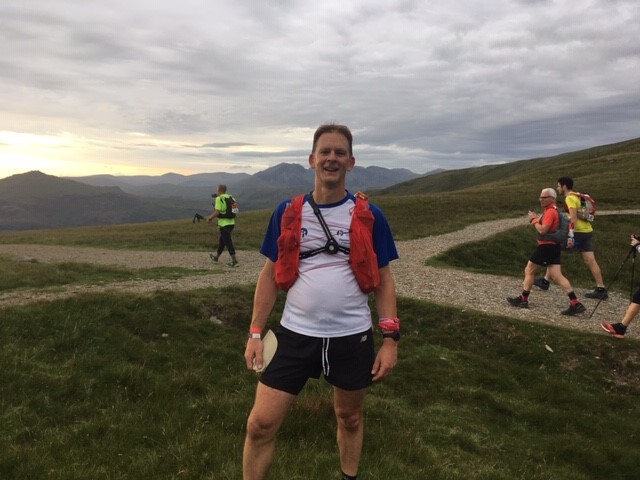
Mile 5.5. 7:30pm Friday 27 July.
Top of the Walna Scar Road with Harter Fell and the Scafell range in the background. At this point in the race I was in about 420th position. Although early evening it was very humid and as early as mile 5 I was putting salt replacement tablets in my water bottles. The photo was taken by a L100 finisher from 2018 out to support the 2019 runners. “It’s really tough, but you’ll love it” she said.
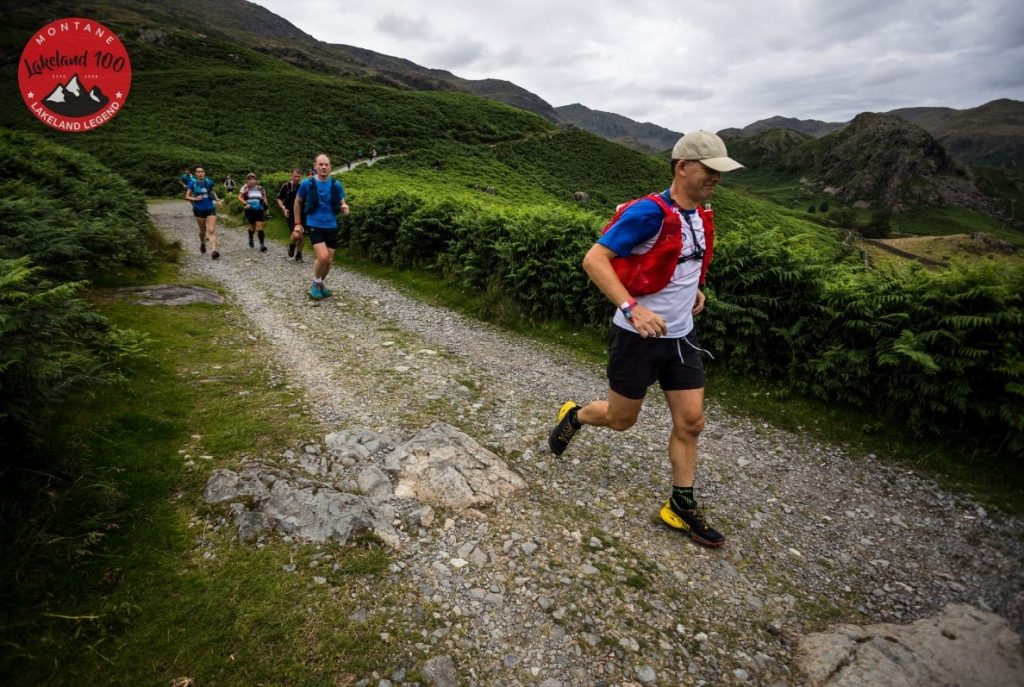
Descending towards the Seathwaite checkpoint.
Leg 2 Seathwaite to Boot (7 miles), 14 miles covered
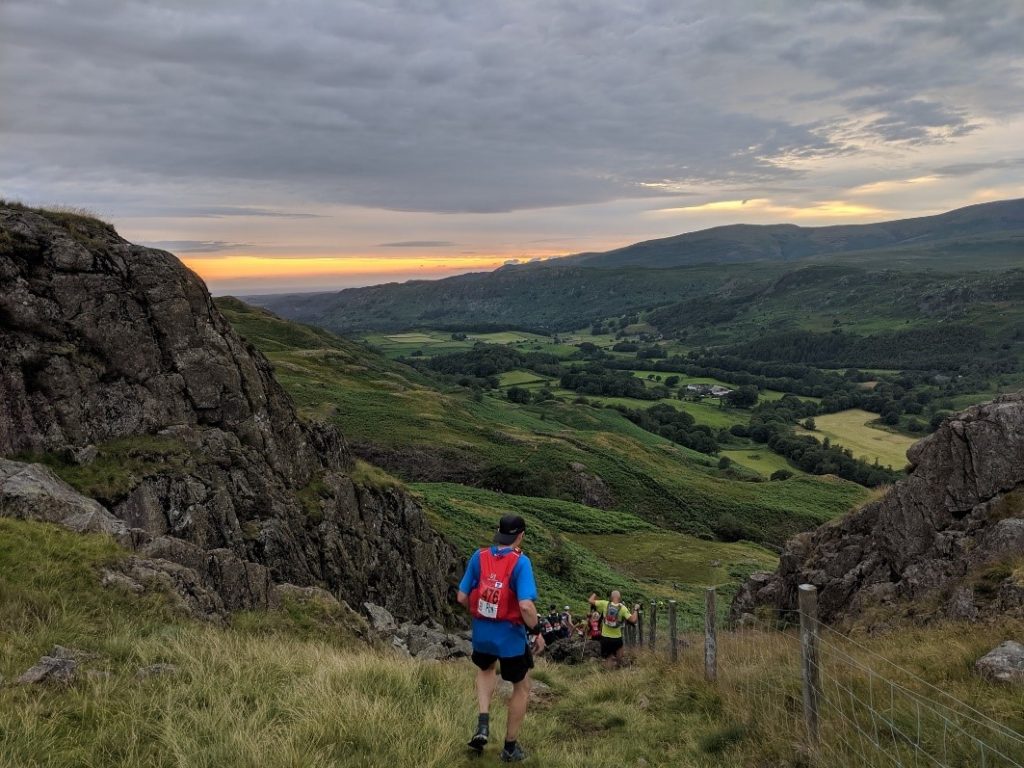
The steep descent into Eskdale, hugging the fence line in single file.
Mile 11. 8, 09:20pm Friday 27 July.
Eskdale is a special place that holds many wonderful memories for me with annual summer camping trips as a boy. I have returned many times to this magical valley over the years and I never tire of its soft and rugged beauty. It is the only valley in the Lake District that does not contain a lake. The winding River Esk and its mountain-born chill waters runs alongside the route for half a mile or so and I pass by St. Catherine’s Church and the stepping stones I played on during those summer camps many years ago. It’s a magical moment of childhood nostalgia. Arriving soon after in the tiny settlement of Boot (old English for ‘a curve in the valley’) at checkpoint 2 at 09:48pm, it was time for biscuits and cake and coke from the Christmas-themed checkpoint (I kid you not, Shakin Stevens’ Merry Christmas Everyone booming from the speakers and marshals dressed as Christmas elves)!
Leg 3 Boot to Wasdale Head (5.4 miles), 19.4 miles covered
From Boot we join the ‘old corpse road’ that runs between Wasdale and Eskdale, and which was, as its name would suggest, used to carry bodies for burial. Although early in the race there are already several competitors who have retired at the first two checkpoints.
Headtorch lights flicker along the valley as we pass the brooding Burnmoor Tarn in the gloaming and descend into Wasdale where a barn has been converted by Sunderland Strollers into a ‘Strollerfest’ that feels more like a Tyrolean beer festival than a checkpoint at an ultra. Four Geordie lasses are doing The Birdie Song dance (yes, that one where you flap your arms manically and wiggle your legs) as I wolf down three cheese and pickle sandwiches and, deciding that the long ascent of Black Sail Pass is mildly preferable to The Birdie Song on a loop, I peel myself away from the checkpoint.
Leg 4 Wasdale to Buttermere (6.9 miles), 26.3 miles covered
Much of the next hour is spent toiling up and up and up and up, on what seems like an endless stairway, if not to heaven, then somewhere close to it. At one point I look up and confuse the headtorch lights high above me for stars. Far below lights are twinkling white in a long line. Just
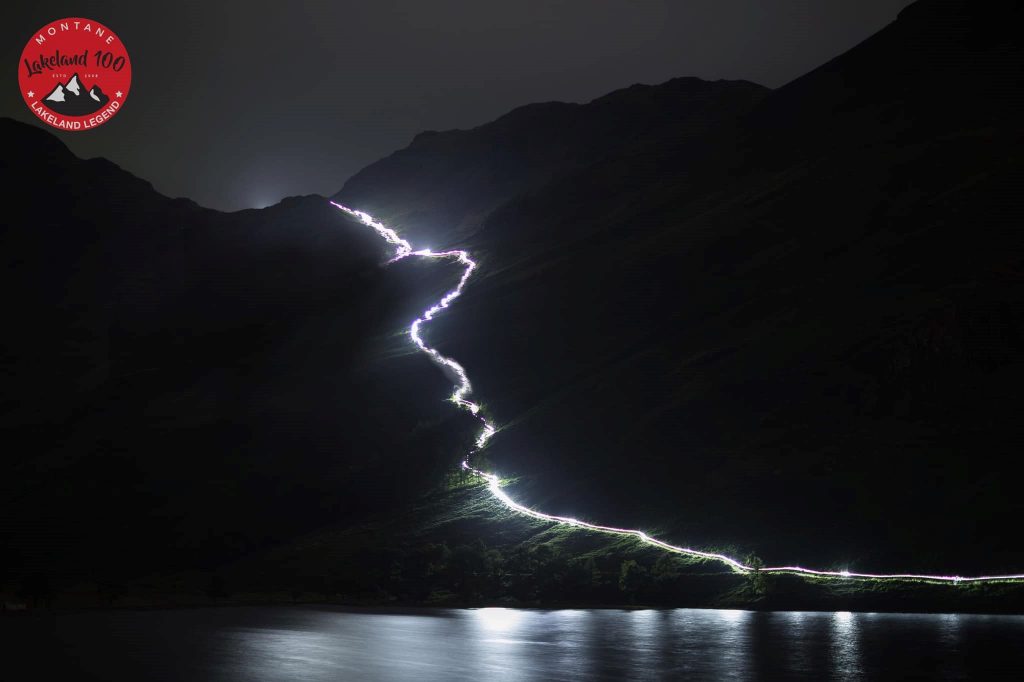
magical. It’s still incredibly humid and at each stream crossing I dip my head in the cooling water that runs off the fells. I’m also taking care to hydrate well and put Tailwind and Mountain Fuel sachets into my water bottles. Descending into the Ennerdale Valley and past the Black Sail Hut hostel at 01:30am, I see three ‘spectators’ out on the course. Now that’s one way to spend your Friday night! Finally, at 02:10am on Saturday morning I arrive at Buttermere Village Hall checkpoint.
The descent from Scarth Gap Pass to Buttermere, 01:50am and 25 miles covered.
The checkpoint theme at Buttermere is ‘The Day of the Dead’ and I’m greeted by a runner bent double and throwing up in the road and then by a human skeleton as I dib my timing chip, or, at least, a guy in a skeleton outfit. Inside the village hall itself the scene is one of subdued desolation. There are about 20 people crammed into the small room and quite a few runners who have retired here, they are sitting on chairs, head in hands, looking disconsolate or talking about the injuries they have picked up which mean that they can’t continue. It’s not a place to linger. I grab a couple of hot dog sausages lathered in rich brown sauce, a couple of slices of bread and a hot steaming mug of coffee and then I’m on my way again.
Leg 5 Buttermere to Braithwaite (6.5 miles), 32.8 miles covered
“In the still of the night
as I gaze out of my window at the moon in its flight, my thoughts all stray to
you” (The Five Satins)
What a beauty this leg was. In the still of the night. New trails
for me contouring the north-western fells above Sail Beck. A real highlight of
the race this section, lost in my own thoughts with an elongated stream of
headtorch lights indicating the twisting snaking climb of the paths ahead. It’s
very quiet and still, and in this isolated place there is no other light or
noise pollution. Whiteless Pike, Wandope, Scar Crag and Sail loom darkly to our
left as we cross Third Gill and then Addacombe Beck. I get my mug out of my pack
and bend down to the fast-flowing stream to fill my mug and pour water over my
head. I stop dead mid-stoop. Am I hallucinating, or is that a head in the
stream staring back at me? Yes, on closer inspection it is a dark
semi-submerged sheep’s head, its dead black eye fixed in its watery grave. Note
to self – don’t drink directly from the streams! Five minutes later I’m
scrambling up the loose scree of Sail Pass, and after a cut through heather on
a narrow path I’m at Barrow Door, ready for the long grassy runnable descent to
Braithwaite (pronounced ‘Brethet’ by the locals). I sit for 10 minutes or so in
St. Herbert’s Church Hall and wolf down three (yes, three!) bowls of rice
pudding and then a pasta dish with the tangiest spicy tomato sauce. I’m so
pleased that so far I don’t have any stomach issues and I’m eating and
hydrating well.
Leg 6 Braithwaite to Blencathra Centre (8.5 miles), 41.3 miles covered
Half an orange and then I’m out of the checkpoint, walking on the A66 out of Braithwaite slurping a hot cup of tea as I go. I’m joined by Gemma and we chat and run together. It’s 5am and no need for headtorches now. Being so early on a Staurday morning there is very little traffic on the A66 and soon we are off the road and wending our way towards Keswick. Gemma has made the journey from Devon with her husband and two young kids. I lose touch with Gemma on the ascent of Latrigg but soon join Kirsty on the countour around Lonscale Fell north of Keswick. “How far’s the next checkpoint? I’m desperate for a wee! It’s easy for you blokes!” Kirsty (late 20s and from somewhere up north) is great fun, and it strikes me that only in this kind of event would your first conversation with a complete stranger be about going to the loo! Chatting away, the rain starts to fall, intermittent at first and then more persistent but we soon arrive at Blencathra Centre, the next checkpoint with a hard rock theme and where Freddie Mercury (see pic below) offers me a swig of whiskey from a bottle placed on the table next to the sausage rolls and peanut butter sandwiches. I opt for a mug of vegetable soup instead, and soon I’m on my way again, walking out of the checkpoint with another strong coffee, mourning the loss of Kirsty to the not inconsiderable queue outside the ladies loo.
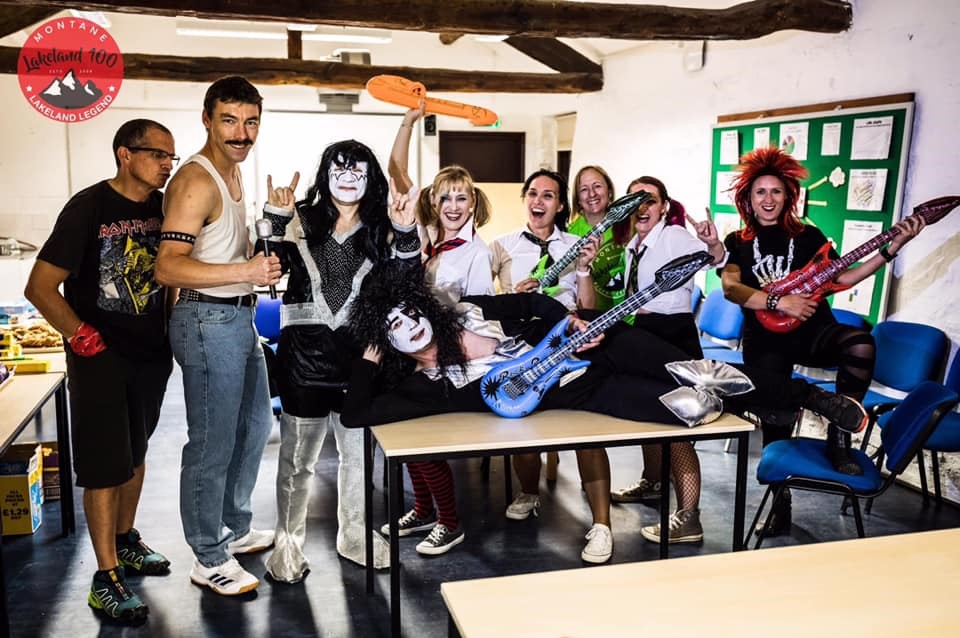
Checkpoint 7 Blencathra Centre, 41.3 miles
“Don’t stop believing, hold on to that feeling.”
Leg 7 Blencathra Centre to Dockray (7.7 miles), 49 miles covered
I fall in step with Annette, 60, who has a fast walk that is quicker than my stumble jog. We spend all of 5 minutes together before she dry retches for a few moments by the side of the road and then shows me a very brisk and clean pair of heels. Crossing the A66 checkpoint is mercifully quick and before long I am on the climb towards Clough Head (memories of my Bob Graham Round attempt from last year) and then settling into a rhythm for the 6km traipse along the Old Coach Road in the pouring rain. Half way along a couple of dark brown wild horses join me and we walk together along the path for a good half a mile. They hold a position to my left on the path and I start talking to them and the lead horse half turns its head and gazes at me with a deep meaningful look, which could mean a) What are you doing here on this long and winding road in the pouring rain? b) Why don’t you just jump on my back and I’ll give you a ride along this track to Dockray? c) You are not even half way through this race and you’re already 5 hours behind the leader.
Leg 8 Dockray to Dalemain (10.1 miles), 59.1 miles covered
Dockray is a desolate makeshift mini-marquee checkpoint that is being absolutely battered by the strong wind and rain. I’m not overly reassured by the dibber marshal saying “Are you feeling ok?” as I arrive. I wonder if I’m starting to look like a White Walker from Game of Thrones with an otherworldly look in my eye. To restore some colour to my face I wolf down a mug of hot soup and grab a handful of cheese and pickle sandwiches. “Stock up, love, it’s ten miles to the next checkpoint” says one of the ever cheerful helpers, who obviously also feels I look less than sprightly. The next three hours feel like seven. I have to keep reminding myself to enjoy the experience and take in the scenery and the views, which admittedly are stunning as we contour Gowbarrow Fell and follow a gorgeous sinewy mountain path above the north-east shore of Ullswater. I use the excuse to pause and take a photo (below), and then hook up again with Gemma who is going strong on this section. Reaching the Dalemain estate after an interminable road section I am buoyed by the 50 mile runners who have started their race at 11.30am from this location and are on their 4 mile loop of the estate. I have a mile running alongside them as they pass me in waves, and I’m so encouraged I break into what can only be described as a slow-motion sprint as they shout their encouragement. “Go on Nick”, “Great job, Nick” “Respect Nick” “Keep it going Nick!” And then, at just after noon, I reach the large checkpoint marquee where delicious vegetable stew and sponge and custard await. Yes! Sponge and custard, and oh my goodness, it tastes like the best thing ever consumed by a human. My drop bag is also waiting for me here, which means I will now have poles for the second half of the course, very welcome for tired legs. I also put on fresh socks but I’m really concerned by the state of my feet, big angry blisters have formed and the skin is albino white and shrivelled. I towel them as dry as I can and sprinkle talc on them, but it all feels a bit late and futile as I leave the checkpoint in an absolute deluge of rain.
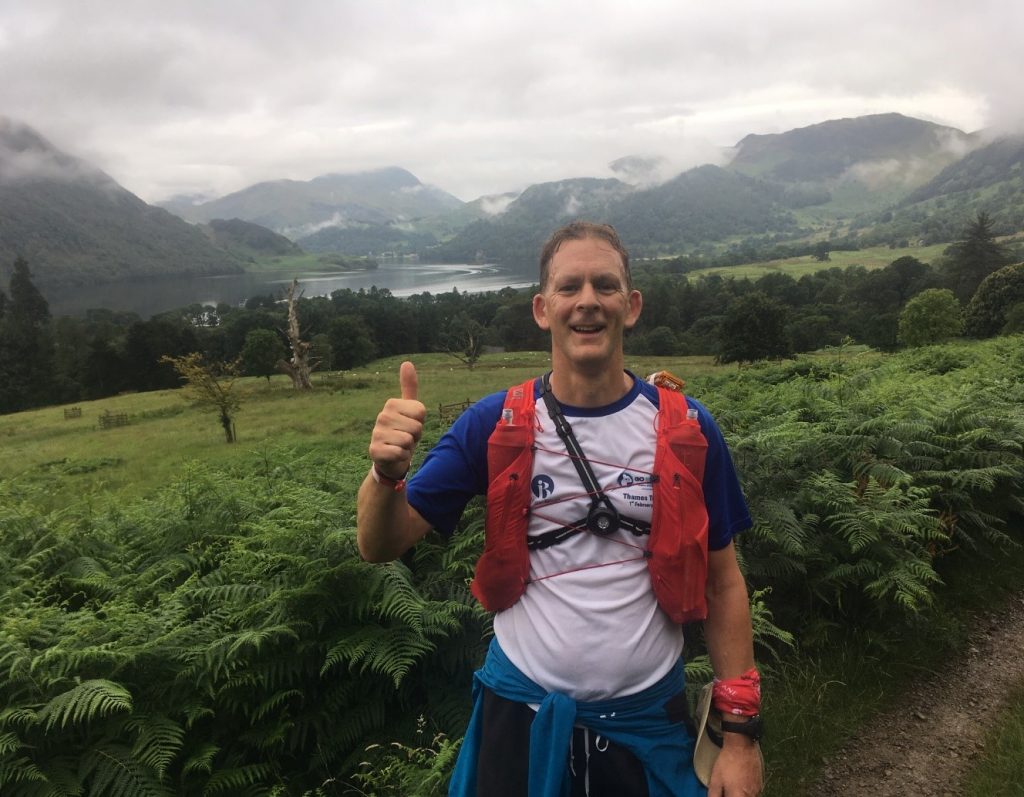
Leg 9 Dalemain to Howtown (7.1 miles), 66.2 miles covered
Very little stands out about this leg other than I was on my own and it was raining heavily throughout. Ullswater to my right, bracken to my left, and the path puddletastic. Every step was sharp pain in both feet. My shoes and socks were sodden. It was impossible to keep them dry.
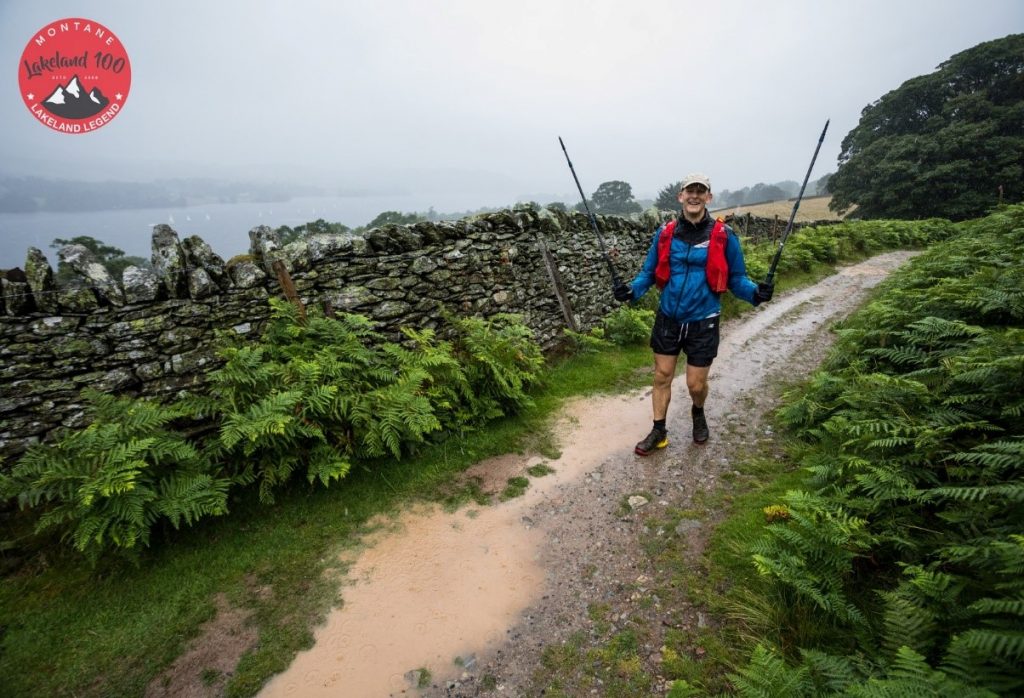
The long and winding road…to Howtown. Mile 64, 20 hours in.
Leg 10 Howtown to Mardale Head (9.4 miles), 75.6 miles covered
This is a beast of a leg, with a long 4.5km leg-sapping climb up Fusedale to the highest point of the route at 650 metres just south of Wether Hill summit. The clag was down, the grassy pathless top a muddy morass. A licorice stick and a bar of Kendal Mint Cake saw me to the top and the descent towards Haweswater was a treacherous slalom along a thin snaking path through bracken with treacherous rocks hidden amid the mud. I passed a runner who had broken his leg on the descent. There but for the grace of God. An isolated and inaccessible single-file rocky cambered path runs along the side of Haweswater in the Mardale valley. Haweswater was the site of a controversial dam project in 1929 which saw the flooding of the villages of Measand and Mardale Green. The path that skirts the reservoir is 6km long and is narrow, strewn with rocks and boulders and undulates the whole way. It was also really treacherous in the wet. There were signs that more than a few runners had fallen into the chest-high bracken. I made tortuously slow progress and by the time I arrived at the checkpoint at Mardale Head almost 4 hours had passed since the last checkpoint and it was now late afternoon, with a strong wind and lashing rain beating down on the makeshift marquee, with runners and volunteers huddling for shelter from the elements. Shivering in the cold and wet, I wolfed down a cup of lukewarm vegetable soup and one of the volunteers helped me to put on my waterproof trousers, my legs struggling to respond. Kirsty arrived and was considering retiring, or getting some sleep before continuing. A lot were retiring here, and it was quickly time to move on.
Leg 11 Mardale Head to Kentmere (6.5 miles), 82.1 miles covered
The climb of Gatescarth Pass started as soon as I left the checkpoint and continued for close to an hour. The wind was raging and the rain relentless. I stumbled down the descent into Longsleddale shadowing two of the 50 mile runners and into the appropriately named Sadgill. Kentmere is a gorgeous valley and the route here wends its undulating way over several walls with steps built into them, through farmland and fields. Enjoying these last few miles of daylight it was dusk as I arrived at Kentmere Village Hall, where Disney was the theme and The Circle of Life got stuck in my head for the next few hours.
Leg 12 Kentmere to Ambleside (7.3 miles), 89.4 miles covered
Many of the checkpoints are immediately followed by a climb, and the Garburn Pass on fresh legs would not be overly taxing, but on tired legs it seemed to go on a while. I had done a recce of this leg in March, but with a tired head and legs and in the dark every turn seemed like a potential navigational trap for the unwary. Eventually, however, I was winding my way through the mystical Skelghyll Wood and hooking up with a couple of other middle-aged men in the woods(!) for the run into Ambleside at just before 1am as some late night revellers cheered us through the town. At the checkpoint I was adopted by an incredibly helpful marshal who sorted me out with food and drink, pepsi and more hot soup. After a brief stop I was determined that Saturday night would be alright for fighting my way to the finish, despite the now horrendous searing pain/agony that every step produced in my feet and lower legs, particularly my right shin which was clearly unhappy with the strain it was under.
Leg 13 Ambleside to Chapel Stile (5.6 miles), 95 miles covered
It took me two and a half hours to travel the relatively flat (only 234 m of ascent) and innocuous five and a half mile section to the Langdale checkpoint, which probably tells you everything you need to know about the physical state I was in at this point. Dark. Cold. Wet. Uncomfortably not so numb. My headtorch batteries faded and I fumbled a battery change. I started getting careless at loo stops too – enough said about what that meant! Finally the ‘runway lights’ of the ‘come fly with me’ themed Chapel Stile checkpoint came into view, the final checkpoint with a cut-off time, and I knew now that barring complete physical shutdown I was going to finish.
Leg 14 Chapel Stile to Tilberthwaite (6.5 miles), 101.5 miles covered
This was the leg where Annette powered past me again (I hadn’t realised I’d gone past her again on the route) as I was having a ‘comfort break’ by the side of the path. This was the leg where a shadowy figure just in front of me fell headfirst into an almighty deep bog, saving me the same ignominy by seconds. This was the leg where the dawn emerged and started to paint the colours of the new day, beautiful greys and greens and blues and soft warm orange. This was the leg where I relaxed about any kind of finish time, the goal was just to finish. This was the leg where I powered into the checkpoint at Tilberthwaite and saw the ‘just over a parkrun to go’ sign. This was the leg where I missed out on the cheese toasties they were serving at the checkpoint, so keen was I to get up ‘Jacob’s ladder’ (the infamous Tilberthwaite steps) and on to the finish.
Leg 15 Tilberthwaite to Coniston (3.5 miles), 105 miles covered
“We’re supposed to be athletes. This is more like the walking wounded in Napoleon’s retreat from Russia!” said one fellow competitor as he hobbled past me at mile 104. I lost a good few places on this final section, but I enjoyed it, absorbing the experience and reflecting on the journey I’d been on during the event.
What did I learn?
Well, on a practical note, I learnt that if it is going to be wet for a long event make sure that feet are well lubricated throughout and change socks regularly. My legs and body felt generally fine. My biggest physical problem was my swollen and badly blistered feet. I learnt that age and gender and body shape are not necessarily indicators to stamina or performance in an ultra of this kind. It appears to be as much about your head and your heart and about one’s personal pain and ‘staying power’ threshold. I learnt that ‘running’ 105 miles in this way is a visceral and life-affirming experience. Not a unique experience, but a highly unusual one which supercharges your senses throughout. I learnt that ultra-runners are kind and generous souls with a strong sense of community and shared experience. I learnt (and I kind of knew this already), that I am well and truly in love with the Lake District. As Arthur Wainwright said: “Surely there is no other place in this whole wonderful world quite like Lakeland…no other so exquisitely lovely, no other so charming, no other that calls so insistently across a gulf of distance.”
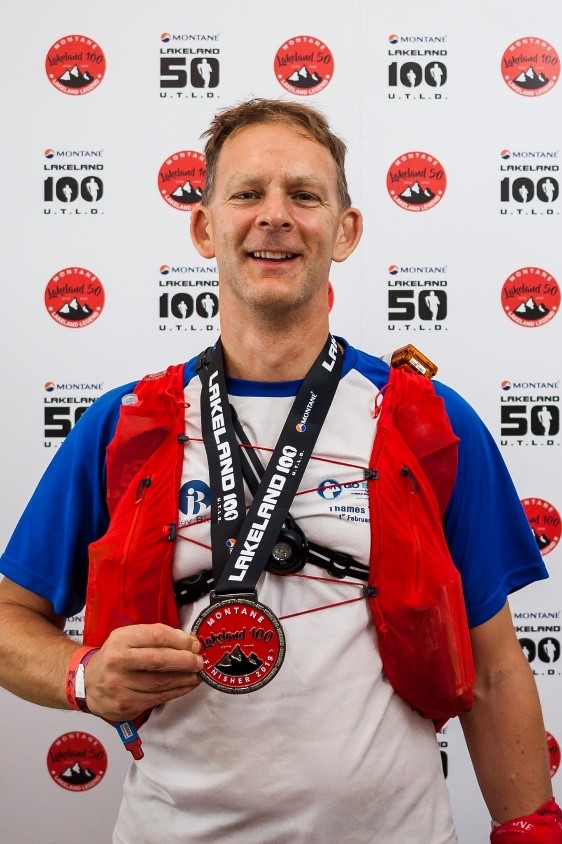
Relief. Exhaustion. Pride.
The Lakeland 100 was a compelling and utterly memorable life experience, which like Lakeland slate and granite is now chiselled into every nerve and fibre. The inner glow is still burning brightly.
People have asked me why I would want to run 105 miles. To me it is about discovering who I am, and understanding a little more about the human condition; how we are made of fragile temporal flesh and blood, how vulnerable we are, how strong we are, and how our mind and body can work in beautiful harmony as well as fierce antipathy and antagonism.
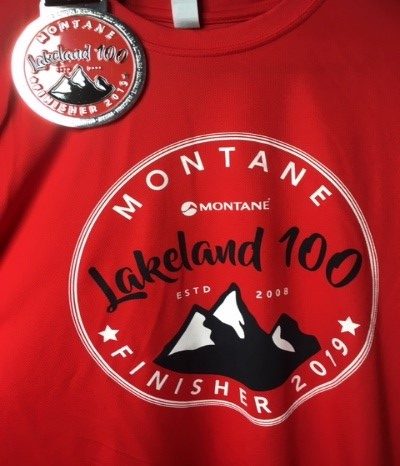
And finally, (photo on the next page not for the squeamish) a foot note…
Drive for a couple of hours on ‘A’ roads and motorways and you’ll average about 52 mph, needing roughly 2 hours to travel 105 miles. It’s a long way in a motorised vehicle on straight flat tarmac roads, never mind undulating uneven Lakeland trails. I occasionally get asked ‘Why would you want to run 100 miles?’ and labelled (affectionately, I hope!) as ‘mad’ or ‘a nutter’. It’s a question I always struggle to reply to, because to me it is the most natural and wonderfully life-enhancing thing to do. Running long distances in beautiful locations has provided me with so many memorable and wonderful life experiences. To me, my character and personality is sharpened in the forge of these experiences, and I see more clearly and deeply a mirror of who I really am. Without wanting to sound pretentious, in part it’s about enlightenment, and an almost spiritual communion with the natural world. This is said without any sense of judgement on others. It’s merely an attempt to shine a light on who I am and what enervates and excites me about life. And how lucky we are to live in this world with so many natural wonders and life experiences to enjoy! And if you’ve got this far, thank you for reading this.
Nick xxx
